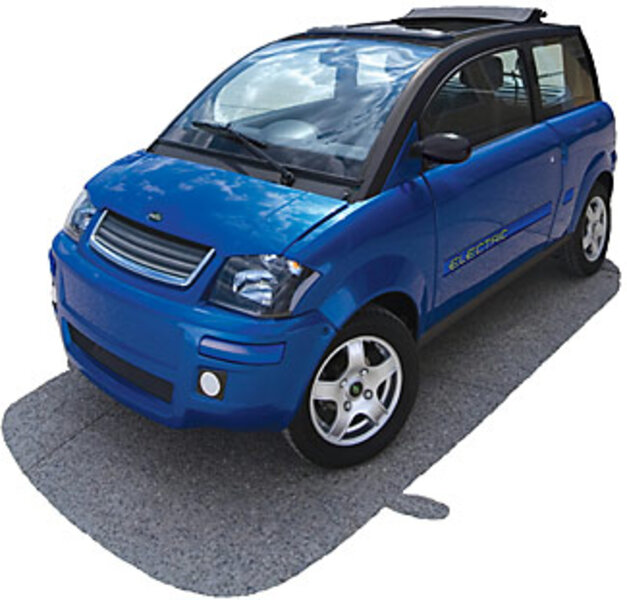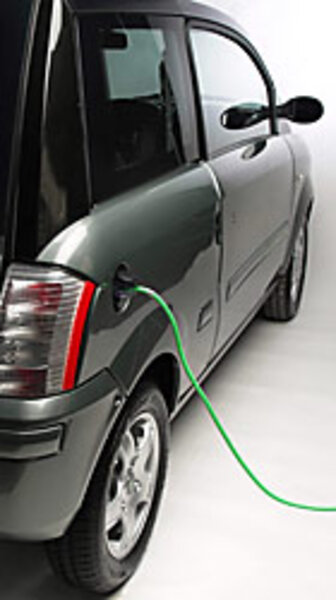Ultracapacitors: the future of electric cars or the 'cold fusion' of autovation?
Loading...
Ian Clifford wants to start a global revolution by building a practical, everyday car with no gasoline engine, no batteries, and no emissions.
While big Detroit automakers ponder a future plug-in car that goes 40 miles on a battery charge before its gas engine kicks in, Mr. Clifford's tiny ZENN Motor, a Toronto maker of low-speed electric cars, announced in March that it will build a new highway-speed (80 m.p.h.) model that goes 250 miles on a charge – and can recharge in just five minutes.
Having no batteries, the new "cityZENN" model will use a breakthrough version of a common electrical storage device called an ultracapacitor to store power from a wall socket, the company says. Fuel costs to operate it would be about one-tenth of today's gas-powered vehicle.
If that astounding claim is real (and there are many skeptics), it could revolutionize automotive travel by making all-electric cars competitive with gas-powered vehicles and easing the world's dependence on oil.
"The big problem has always been the battery and its limits," says Clifford, ZENN's founder and CEO in a phone interview. "This new technology is a 180-degree shift that represents the end of fossil fuel as a transportation fuel."
That's because the same ultracapacitor technology could be used across the grid to provide cheap electric storage for wind and solar power, he says. In turn, this process could power millions of ultracapacitor vehicles with no emissions at all. With the cars' fast-charge capability, recharging stations could pop up to help make even longer trips routine.
Ultracapacitors – also called supercapacitors – are more powerful cousins of the basic capacitor. With activated carbon at their core to act as a sponge for electrons, ultracapacitors can absorb power – or send a charge – far faster than batteries. They are also far more durable.
First used in the 1960s, ultracapacitors today are widely found in electronic devices such as computers. In cameras, they retract and expand zoom lens. Yet the power stored by today's ultracapacitors is still only about 5 percent as much as a modern lithium-ion battery, far too little to power a car by themselves.
The reported breakthrough was made by ZENN's business partner EEStor, a Cedar Park, Texas, firm headed by respected computer industry veteran Richard Weir, who's named on the company's patent. The company is now nearing commercial production of its new "electrical energy storage unit" or EESU, Clifford says.
But privately held EEStor has had little to say publicly or to the press – and that secretiveness has inspired incredulity among many debating the topic on Internet forums.
But in a break with that tradition, Tom Weir, the company's vice president and general manager, responded to e-mailed questions.
"EEStor's technology has the opportunity to touch every aspect of daily life from very big to very small devices," Mr. Weir writes. "We also see a whole new generation of products ... based around our technology."
Added credibility arrived with the January announcement by Lockheed Martin, the big defense company, of an agreement to use EEStor technology for military and homeland security applications. It refers to the EEStor "ceramic battery" providing "10 times the energy density of lead-acid batteries at 1/10th the weight and volume."
In 2005, Kleiner Perkins Caufield & Byers sunk $3 million into EEStor. ZENN also invested $3 million and will get exclusive rights to retrofit vehicles with the system – and produce new mid-size cars using EESUs.
According to EEStor's patent application, the breakthrough is based on a technically arduous process of purifying and fabricating units with barium titanate, a material known to retain vast amounts of power.
"The main feature of the EESU is the charge and dis-charge at electric speed," Weir writes. "This is a key enabling factor for the advancement of the next generation of vehicles. Another feature is the amount of power the EESU can store. Lastly, the EESU is expected to be considered fully 'green.' "
But some bloggers call the purported breakthrough pure hype, today's version of "cold fusion," the still-theoretical energy source announced in 1989.
At least some analysts and researchers, though skeptical, seem reluctant to dismiss entirely the possibility that EEStor could be onto something significant.
"I'm sure they do have a technology, but skepticism revolves around the fact that nobody knows much about it," says Anu Cherian, an analyst who tracks the $100 million global ultracapacitor market for Frost & Sullivan, a growth consulting company. "The ZENN car looks to be an exciting development. But there's a lot of hype in the market."
Other ultracapacitor experts won't dismiss EEStor's claim despite technical challenges.
"It would be unfair to make an analogy between what EEStor is doing and cold fusion," says Joel Schindall, a Massachusetts Institute of Technology professor who is using nanotechnology to improve ultracapacitors. "I don't doubt that they have built a device on a small scale that does store the amounts of energy they are talking about. I just don't know if they can manage the process of scaling it up ... for commercial applications."
Dr. Schindall and his colleagues hope soon to demonstrate a fivefold boost in ultracapacitor energy storage to up to 25 percent of the energy storage capacity of a lithium battery – and someday up to 50 percent – using a different approach to the problem.
Such significant advances would make ultracapacitors viable in vehicles, though they still fall far short of Clifford's claims about EESU.
Making commercial quantities of EESUs could prove challenging since even tiny impurities and defects in manufacturing could result in "a violent discharge," Schindall notes.
Safety is a huge issue for energy storage in vehicles whether powered by gasoline, ethanol, hydrogen, batteries – or ultracapacitors. High-capacity lithium-ion battery research for cars, for instance, is focused on ensuring those devices don't burst into flames. EEStor has ensured that its new ultracapacitor will be safe if damaged in a crash by "instantly discharging to ground," Clifford says.
Skeptics don't bother him, he says, because "we've seen this product with our own eyes."
"We've had a great 100-year run with petroleum," Clifford says. "But the time has come for all of us to come to our senses now and realize that the electric-powered era for cars has finally arrived."
Comments from EEStor
Much of the rampant skepticism on the Internet over whether or not EEStor has had a breakthrough in automotive propulsion stems from the company's reticence to speak or to demonstrate its product publicly. Only a handful of press releases have been issued since the company was formed, and press reports have rarely included any direct quotes from company managers. Below are comments from a Monitor e-mail interview with Tom Weir, vice president and general manager, EEStor, Inc.
Can you offer an idea of what your product could do for automotive transportation and a time horizon for development?
"We see our Electrical Energy Storage Unit, 'EESU,' enabling the next generation of electric vehicles. The main feature of the EESU is [its ability to] charge and dis-charge at electric speed. This is a key enabling factor for the advancement of the next generation of vehicles. Another feature is the amount of power the EESU can store. Lastly, the EESU is expected to be considered fully 'green.' "
Some have suggested that ultracapacitors will play more of a supporting role – others that it's a "game changer," or even world changing. How would you describe the potential?
"EEStor's technology has the opportunity to touch every aspect of daily life from very big to very small devices. We also see a whole new generation of products and services that [are] based around our technology."
How would you characterize EEStor's contribution to developing new systems to transmit the energy for automotive propulsion?
"No comment."
EEStor has announced passing an evaluation on purity of its production process. Explain why this is important.
"To be discussed in the near future."
Why has EEStor been so quiet, some say secretive, about what it is doing?
"We talk about our achievements through press releases. We talk with our current customers almost daily. We will also talk about more things when the time is right."
Do you see any show stoppers, or is it just a matter of ramping up?
"With any start-up you have some speed bumps that come up from time to time. We have no show stoppers."






